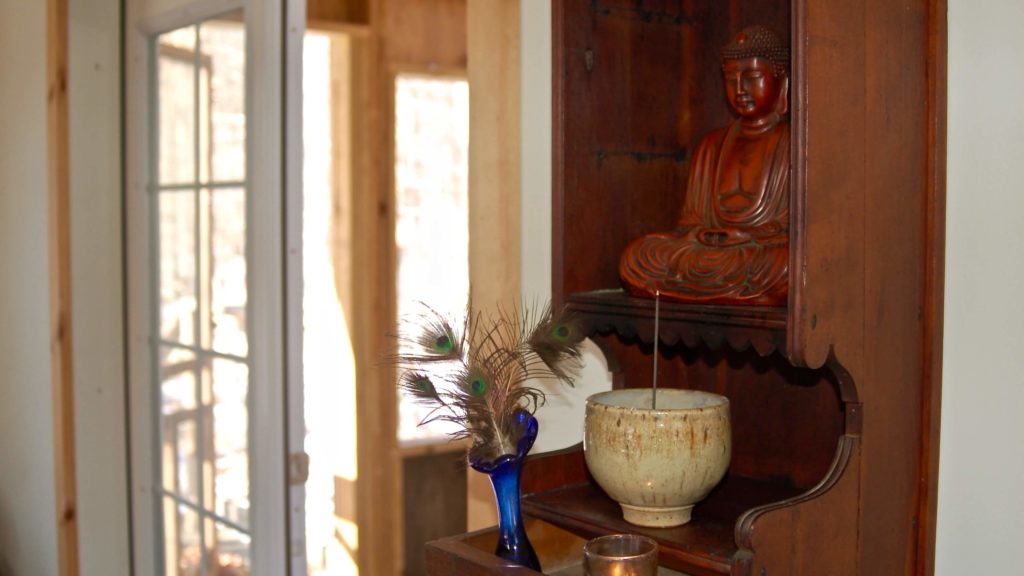
I WOULD LIKE TO GIVE A TALK this morning about the basics of zazen practice. To clarify, if possible, the basics of the actual practice of zazen, so that when you sit down to practice, you don’t have to deal with any doubt or question about what you should be doing. Even though it is actually impossible to explain, I’d like to try anyway.
The difficulty people have in zazen practice is that they are coming into it with an “I am” self residing in the thinking activity. When that self tries to practice zazen, it thinks it has something to do with manipulating the thinking activity, by thinking that peace comes through suppression of thought. But the practice of zazen is not performed by the thinking activity, so the self that you take yourself to be has nothing to do; there is nothing that needs to be done to or with the mind to practice zazen. The mind just is as it is. But we get caught in judging it, or using it, or daydreaming. We don’t have any other tool besides the thinking activity if “I” is immersed in the thinking activity. This is the situation.
Please understand that if you are using the mind to practice zazen, you will never get far. Instead what we are trying to do is to get out of the way to allow the awareness to caress the breathing activity; we are allowing the experience of our body breathing. We cannot produce that experience as a self in the thinking activity, because thinking cannot be aware of breathing.
Thinking does not have to disturb if you just allow it to be, and refrain from judging it or interacting with it. Another way of explaining “allowing” is relaxing. Instead of trying to work with the mind, take the body and make sure the shoulders are soft, make sure the neck is upright but soft, and the arms are soft, and the chest and belly are soft. In the softening of the body is the invitation to experience it; so that when your body is proper and the breathing is taking place as an activity, and you are relaxed, then the awareness of the breathing is more accessible. You are leaning into the physical feeling of the breathing activity. Thinking is going to disrupt that contact, but reacting to thinking is a mistake. You have to be prepared to allow the thinking to be as neurotic and distracting as it needs to be. There is no problem with the thinking activity except in wanting it to be other than the way it is. If you do not want thinking to be other than the way it is, thinking will not bother you. Just be there, and after a short period of practice like that, you will be able to smile at the thinking activity.
The practice is to lean into the breathing activity. When Buddha described it, he said, “Breathing in, there is the full penetrating awareness of breathing in, and when breathing out, there is the full penetrating awareness of breathing out.” Please understand that you cannot do that; you can only allow that by relaxing.
If you persevere in this way, the inner environment takes on a very different flavor from when you were struggling with the thinking activity. Suddenly, all peace breaks loose! You can start to see the path, and the path is that when you allow the awareness and the breathing to caress each other, to be intimate with each other, you will feel happy and clear and at ease. You will be engaging the proper way to extract the self from the thinking activity, which is Zen practice. Your will is not capable of suppressing thinking. So if your defense against negative thinking states is to run from them or suppress them, you will never be safe because they will overpower you.
I was talking to a friend yesterday who is in a lot of physical pain. And not only was he in a lot of physical pain, but he thought he could suppress it with his will. When he failed in that effort, he felt even worse. Things are just as they are, and the only thing out of place is your will. Practice is to give up the fight with the thinking activity, to give up the fight with things as they are, and come back home to your deeper state. It cannot be described, but you can hint at it by saying, “When breathing in, I am relaxed and aware of breathing in, when breathing out, I am relaxed and aware of breathing out.” And when thinking disrupts, “I have nothing to say about that, that is your business. You are on your own.”
Practice in that kind of way, and you will find sitting down to be a very welcoming state—there is no fight with the thinking activity. Your tendency toward aggression has been released. It is just, “OK, you are free now to go roam. I am sitting at home, relaxed and experiencing myself being relaxed.”
—from A Temporary Affair, a collection of talks by Yoshin David Radin
